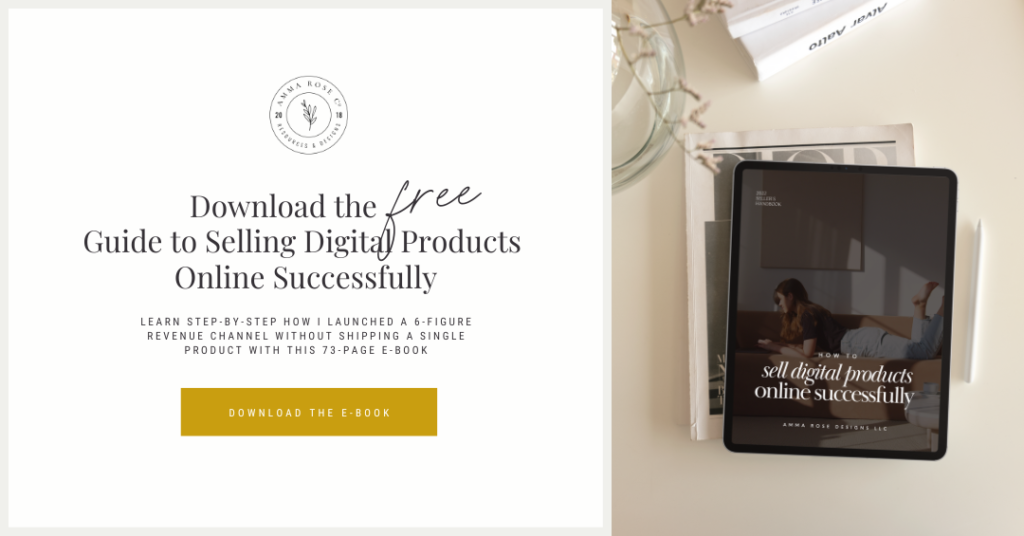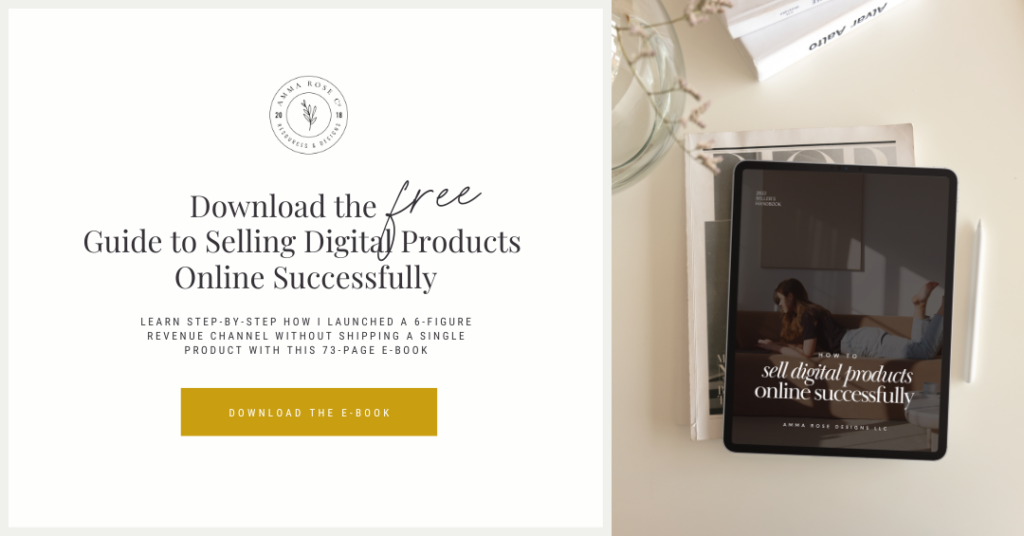
What I Wish I Knew When I First Started Designing Printables
It’s no secret that printables are big business. Many people are looking for ways to organize their lives, save time, and make things easier. By creating printables that solve a problem or help people achieve a specific goal, you can easily tap into this growing market and make some serious profits.
Printables are relatively easy and inexpensive to create, so they’re a great product for anyone just starting out in the world of online entrepreneurship. But even if you’re a seasoned pro, there are always ways to improve your printables and make them more effective.
It’s important to keep in mind not all printables are created equal. In order to make your printables stand out from the crowd and actually sell, there are a few things you should consider as you’re putting your idea on paper. In this blog post, I’ll share my proven tips as someone who has exclusively sold printables for over 4 years for creating printables that not only sell, but also provide value to your audience.
Keep reading to learn how to create digital products to sell!

Table of Contents
1) Ask Your Audience What They Want
It seems like a no-brainer, but you would be surprised how many people create printables and then try to sell them without actually knowing if there’s a demand for them.
Before you start creating your printable, take the time to reach out to your audience and ask them what type of printable they would be interested in. This can be done through a survey, social media poll, or even just asking for comments on a blog post.
By taking the time to find out what your audience wants, you’ll be able to create a printable that they’re actually interested in buying. This will save you time and money in the long run, and it will help you create a product that people will love.
2) Keep Functionality in Mind as You Design
Your printable may look pretty, but if it’s not functional, people will quickly get frustrated and won’t want to use it. When you’re designing your printable, opt for functionality over aesthetics.
Ask yourself how people will be using your printable. Will they be printing it out and using it as a physical product, or will they be accessing it digitally? If people will be printing it out, will they need to print it on standard printer paper or will they need to use a special size? Would your audience rather have multiple prompts to guide them through their product, or something that’s more straightforward?
This is why studying and researching your target market beforehand is so important to the success of your business. You are, at the end of the day, designing a product that is meant to be useful for them, so you’ll have to be thinking about their needs, wants, and desires as you’re going through the creation phase.
By prioritizing functionality, you’ll be able to create a printable that people will actually want to use. Here is a checklist of functional factors to keep in mind:
- Spacing: You don’t want a product that’s cluttered. Make sure there is enough space so that people can easily write or enter information
- Print Friendly:
- Consider the types of colors you use and how they may turn out different once printed
- If your audience is meant to print their product at-home instead of professionally, don’t use too much color so it doesn’t use a lot of ink once printed
- If your design requires color or different elements to be printed from edge to edge, add in a Page Bleed so there’s no gaps in your design
- Be clear on the trim size, or the size of paper, needed to print effectively
- User Interface: Make your product an enjoyable experience for your users, including things like making sure your text isn’t too small to read and ensuring your prompts are easy to follow
- Page Margins: This is the area between the main content and the edges of the page. Typically, you wouldn’t have your content go all the way to the edge of the page. Pick a margin size and stick with it for consistency
It’s also important to consider the format of your printable. Will it be a PDF that people can download and print, or will it be an interactive online document? If you’re not sure which format to use, reach out to your audience and ask them what they would prefer.
3) Prioritize Adding Value
Printables are created to solve a problem. When you’re creating your printable, it’s important to add as much useful content as possible. The more value your printable has, the more likely people are to buy it and continue visiting your shop for more.
It’s of crucial importance that you focus more on creating a product that solves a specific problem, rather than a product that looks “cute.” There are a ton of pretty printables out there, but not all of them are actually useful.
To do this, there are three steps you could take:
- Heavily research your topic, taking note of the solutions that help people the most. Then, develop your product around those solutions
- Utilize your own experiences in the topic. If you have a specific method or process that works, create your product based on that
- Again, reach out to your audience and ask. Once you know what people are looking for, you can add those features to your printable
I typically do a combination of all three of these steps to create the most optimized product for my users.
Nonetheless, the sky’s the limit when it comes to adding value to your printable. By focusing on creating a product that is genuinely helpful, you’ll be able to create a printable that people will love.
4) Simple is usually best
When it comes to printables, simple is usually best. People don’t want to be overwhelmed with a ton of information, so it’s important to keep your printable simple and straightforward.
A good rule of thumb is to:
- Include only the essential information in your printable
- Always try to avoid cluttered and visually chaotic designs
- Anything that is non-essential can be left out
- Use clean lines and stick to 2-3 different colors or less
- Use 1-2 different complimenting font pairings. For instance, you could either pair a serif font with a sans serif font, or a script font with a sans serif font
People can always add their own personal touches to the printable, but it’s important to keep the design simple. By doing so, you’ll be able to create a product that is both user-friendly and stylish.
5) Run a Test Print
Once you’ve designed your printable, it’s important to run a test print. This will allow you to catch any errors or mistakes before you sell your product.
To run a test print, simply print out a copy of your printable on regular printer paper. Once you’ve printed it out, take a close look at the design and make sure everything is how you want it.
Check to make sure that all of the text is legible and easy to read. Also, make sure that the colors are printing out correctly. If you’re not happy with the way the printable looks, make the necessary adjustments and then run another test print.
It’s better to spend a little extra time making sure your printable is perfect before you sell it, rather than getting a bunch of complaints from customers. It’s also a good idea to ask a friend or family member to take a look at your printable before you sell it. They may be able to catch something that you missed.
6) Provide Instructions and Suggestions
When you sell your printable, it’s important to provide instructions and suggestions on how to use it, download it, and how to print it. While it may seem like common sense, for many people this might be their first time purchasing a digital download or using a printable, so it’s your job to provide them with some guidance.
It’s also a good idea to provide some general tips on how to get the most out of printables. For instance, you could suggest that people laminate their printable or create tabs to effortlessly flip through a printable with multiple pages. By providing instructions and suggestions, you’ll be able to help people use your product in the best way possible and eliminate potential questions down the road.
7) Be Open to Feedback
Finally, it’s important to be open to feedback from your customers. After someone has purchased your printable, take some time to follow up with them and see how they’re using it.
If they have any suggestions on how you could improve the product, be sure to take their feedback into consideration. It’s also a good idea to ask for a review or testimonial that you can use on your listing page.
By being open for feedback, you’ll be able to improve your product and provide your customers with an even better experience. It’s also a great way to show that you’re committed to providing high-quality products.

How to Create Printables that Sell
It can be tricky to create printables that sell, but if you follow these tips, you’ll be well on your way to success. Always remember to focus on quality over quantity, keep your design simple, and be open for feedback from your customers. These are just a few tips to keep in mind when creating printables that sell. By following these tips, you’ll be able to create a product that is both stylish and user-friendly. Happy creating!
“Thank you for sharing these expert tips for creating printables that sell on your blog. As someone who is passionate about designing and selling printables, I’m always seeking guidance to improve my strategies and increase the success of my offerings.
Your article provides valuable insights into the key aspects of creating marketable printables. The tips you’ve shared are not only practical but also backed by expertise, making them a valuable resource for both beginners and experienced creators.
I particularly appreciate the emphasis on researching market demand. Understanding the needs and preferences of our target audience is essential for creating printables that resonate with them. Your advice to identify popular niches and trends allows us to tap into lucrative markets and offer products that are in high demand.
The tip about understanding the target audience is crucial. By knowing their pain points, interests, and aspirations, we can develop printables that address their specific needs and provide practical solutions. This understanding enables us to offer unique value and stand out in a competitive market.